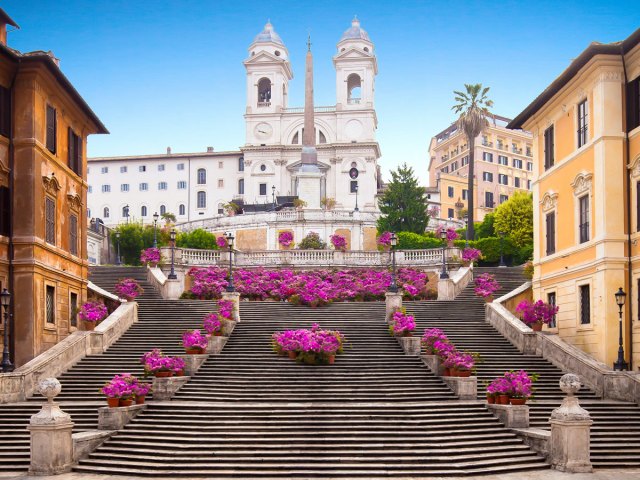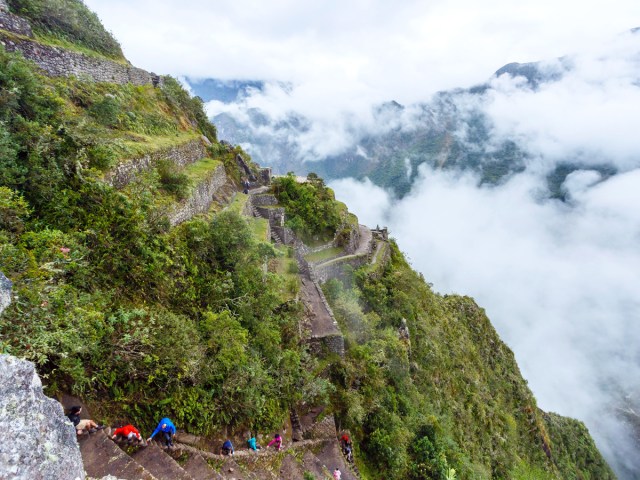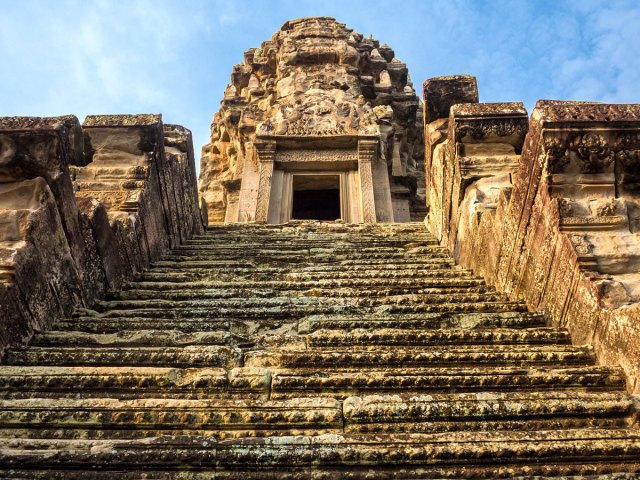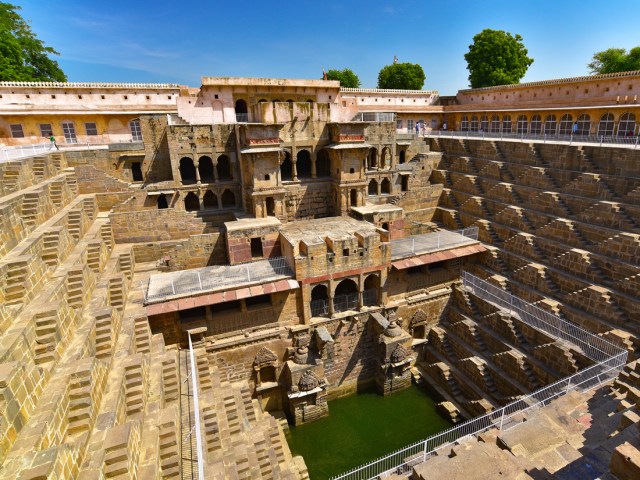Staircases are found all over the planet, but not all staircases are run-of-the-mill. Some come with a long and complex history, while others became famous for their appearances in Hollywood films. Some are just as architecturally spectacular as the museums and monuments in which they are found. These are 11 famous staircases you should seek to climb on your travels.
El Peñón de Guatapé – Guatapé, Colombia

Guatapé is a small, colorful town located 50 miles west of Medellín, making it a popular day trip or weekend destination for those seeking a slower pace. The town is famous for its bright facades (known as zócalos) painted on the sides of homes and storefronts, but, most of all, for El Peñón de Guatapé, a 650-foot rock that towers above everything else.
A brick staircase with 740 steps is embedded into a large crack that runs the height of the rock, transporting climbers in a zigzag fashion all the way to the peak. On average, the climb to the summit takes about 30 minutes. But those efforts will certainly pay off — at the top, you’ll be rewarded with panoramic views of the expansive lake system and rolling emerald hills surrounding Guatapé.
Spanish Steps – Rome, Italy

Don’t let the name confuse you — the Spanish Steps are actually in Rome, Italy. So how did this famous landmark get its name? Connecting the Piazza di Spagna (Spanish Square) to the Trinità dei Monti, a spectacular Renaissance church, the 135-step staircase is known as the Scalinata di Trinità dei Monti in Italian. Its English name, the Spanish Steps, comes from the original location of the Spanish Embassy in the Piazza di Spagna in the 17th century. (And to make matters more confusing, the stairs were commissioned by a French diplomat.)
Built between 1723 and 1725, the ornate staircase is a true Baroque masterpiece. The steps’ central location in Rome makes them an essential stop on the tourist agenda, and they are a beloved and picturesque spot for locals and visitors alike to hang out.
Huayna Picchu Stairs – Machu Picchu, Peru

Machu Picchu, Peru’s most-visited tourist attraction, sits on a high ridge in the Andes Mountains as a stunning example of 15th-century Inca engineering. Visitors come to admire its well-preserved temples and palaces, alongside epic views of the surrounding peaks. The trek to Machu Picchu takes days, and the feat isn’t over until the so-called “Stairs of Death” are conquered.
The staircase, carefully carved into the mountain, ascends to the summit of Huayna Picchu, offering a breathtaking vantage point overlooking the ancient city of Machu Picchu. With 1,000 steep and challenging steps, the climb demands a high level of fitness and agility. However, the stunning panoramic views from the top are the reward for those who complete this exhilarating climb.
The Rocky Steps – Philadelphia, Pennsylvania

The steps at the foot of the Philadelphia Museum of Art rose to fame following their Hollywood debut in the 1976 classic film Rocky. The scene — in which the titular character (played by Sylvester Stallone) powers up the museum’s staircase during his boxing training — served as inspiration for underdogs everywhere. The bronze Rocky statue that was built for scenes in the sequel Rocky III sits at the bottom of the steps and is a popular spot for visitors to snap a photo. Even if you’re not a Rocky fan, the view of Philadelphia from the top of the stairs is one of the best in the city.
Bramante Staircase – Vatican City

The Pio-Clementino Museum in Vatican City houses some of the world’s most prized artworks. However, it’s not just the paintings and statues that catch the eye of art lovers: The museum is also famous for its stunning Bramante Staircase. There are actually two staircases with this name — the original, built in 1505, and the modern one, designed by Giuseppe Momo in 1932.
The original Bramante Staircase follows a double helix design and was built for Pope Julius II. Unfortunately, that staircase is closed to the public, but the modern version — designed to mimic the original — is open to museumgoers today. It’s quite a sight to stand at the top of the stairs and watch the people below snake their way to the bottom of the seemingly never-ending spiral.
Sanctuary of Bom Jesus do Monte – Tenões, Portugal

This 18th-century Catholic shrine in Tenões, in northern Portugal, is a major pilgrimage destination for Christians. A UNESCO World Heritage Site, it is also one of the most significant religious and architectural landmarks in Portugal. Along with its gleaming white plaster facades and exposed stonework, the sanctuary’s most famous feature is the celebrated Sacred Way staircase.
The 579 stairs — broken into three distinct staircases called the Pórtico staircase, Three Virtues Staircase, and Five Senses Staircase — zigzag sharply to the pinnacle of the complex, where the church and gardens sit atop a hill. The staircase is adorned with statues, fountains, and intricately carved columns. While pilgrims traditionally climb the stairs on their knees during Holy Week, visitors are welcome to walk the stairs or take the funicular to the top for the panoramic views over nearby Braga and the Portuguese countryside.
Angkor Wat Temple Stairs – Siem Reap, Cambodia

It’s a tall task to pick a standout element in a place as grand as Angkor Wat — the world’s largest religious structure — but the steep steps attached to the exterior of the temple are a worthy contender. Leading up to the top of Angkor Wat’s tower are three sets of staircases that become increasingly steep as they ascend. The third set of stairs is set at a 70% incline, purposely built to represent the difficulty of reaching the kingdom of the gods. It’s one of the world’s steepest staircases, but your reward for trudging to the top is an epic view over the temple and the rest of Angkor, which was the seat of the Khmer kingdom from the ninth to 15th centuries.
Tiger & Turtle Magic Mountain – Duisburg, Germany

This art installation in Duisburg, Germany, resembles a roller coaster but invites visitors to explore its twisting paths on foot rather than by motorized cart. Created by artists Heike Mutter and Ulrich Genth in 2011, Tiger & Turtle was built upon a slag pile within Angerpark, an urban park in northern Duisburg, a region known for its steel industry and bustling inland port. Today, efforts have been taken to transform the area into a cultural hub through art installations.
Tiger & Turtle stands 69 feet tall, and its 249 steps twist into looped paths that offer unique views of the Rhine River and Düsseldorf, along with contrasting views of the bustling steel factory on one side and a dense forest on the other. The modern “mountain” is especially attractive at night, when it’s lit up with 880 LED lights.
Heaven’s Gate Stairs – Zhangjiajie, China

To reach the stairs of Heaven’s Gate — located in the Tianmen Mountains in the northwest of China’s Hunan province — visitors must first take a 30-minute ride on the Tianmen Mountain Cableway to climb the 4,000 feet to the base of the stairs. Looming above the base are the 999 steps to the top of Tianmen Cave, popularly known as the “Gateway to Heaven.” The number is purposeful: As the highest single digit, the number nine represents eternity and longevity in Chinese numerology. Centuries ago, one side of the cave collapsed, leaving what now appears to be an actual door to the heavens above. Measuring 430 feet tall by 190 feet wide, and sitting roughly 5,000 feet above sea level, Tianmen Cave is the highest naturally formed arch in the world.
Chand Baori – Abhaneri, India

Located in the village of Abhaneri in the Indian state of Rajasthan, Chand Baori is a stepwell that extends roughly 100 feet into the ground, making it one of the deepest and largest of its kind. Stepwells were commonly built in India for centuries, particularly in arid regions, to provide access below the water table for drinking and agriculture. Chand Baori was built in the eighth century and named after a local ruler, Raja Chanda.
The stepwell features 3,500 steps arranged in intricate, yet functional geometric patterns, leading down to a still pool of water at the bottom. There was once a palace built around Chand Baori; however, these rooms are not accessible to visitors today. But visitors can walk down the steps and notice how the temperature drops by about 5 to 6 degrees Fahrenheit at the bottom of the well. As a proven way to beat the heat, stepwells continue to be popular gathering spots and cool retreats for locals centuries later.
Batu Caves – Selangor, Malaysia

The Batu Caves are tucked within a towering limestone rock in Selangor, located 8 miles north of the Malaysian capital of Kuala Lumpur. The popular tourist attraction and significant religious site is one of the most-visited places in the capital region. To access the cave system, visitors must climb 272 concrete steps. The base of the staircase is marked by a massive golden statue of the Hindu deity Lord Murugan, which, at 140 feet, is the tallest statue in Malaysia. The wide, painted steps ascend to the main cave, known as Temple Cave, which houses several Hindu shrines and statues.
Another popular cave to visit within the Batu Caves complex is the Museum Cave, featuring exhibits on Hindu art, culture, and history. Meanwhile, Art Gallery Cave displays Hindu sculptures and paintings, and Ramayana Cave showcases depictions of scenes from the Hindu poem “Ramayana” through colorful statues and murals.
More from our network
Daily Passport is part of Optimism, which publishes content that uplifts, informs, and inspires.























